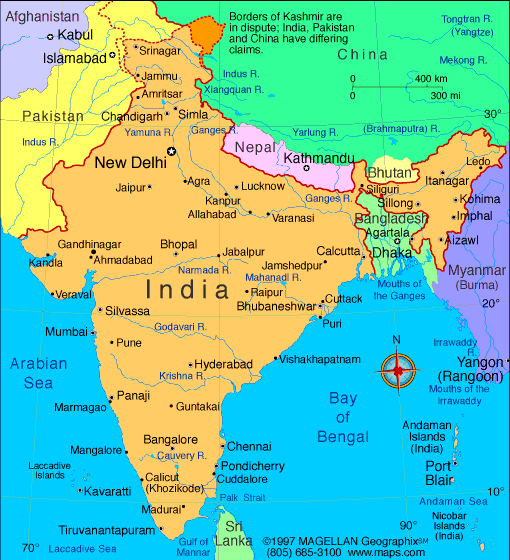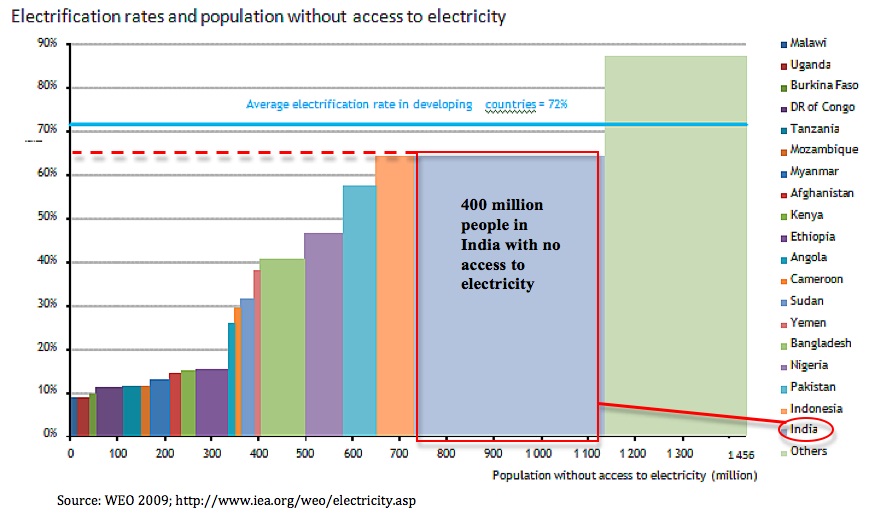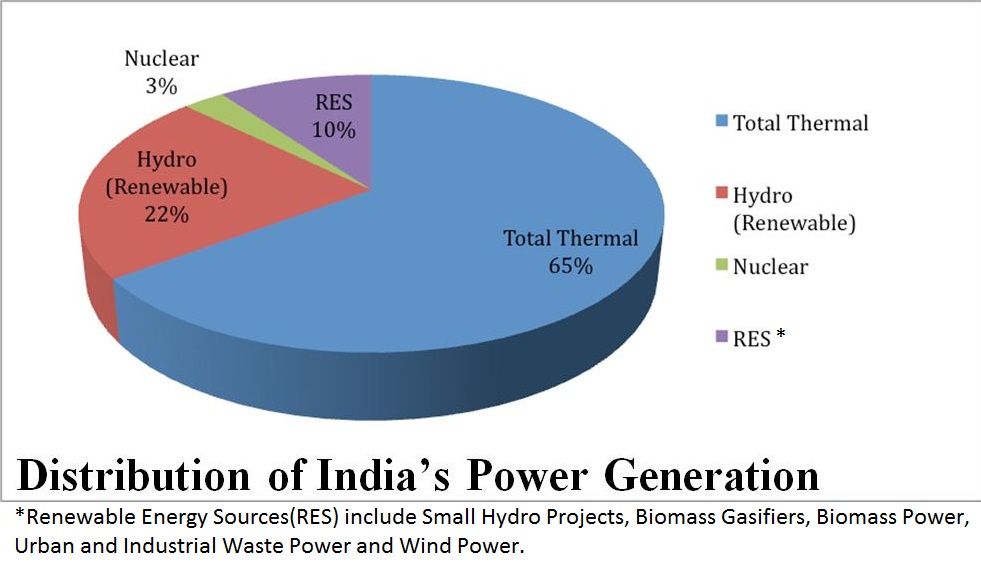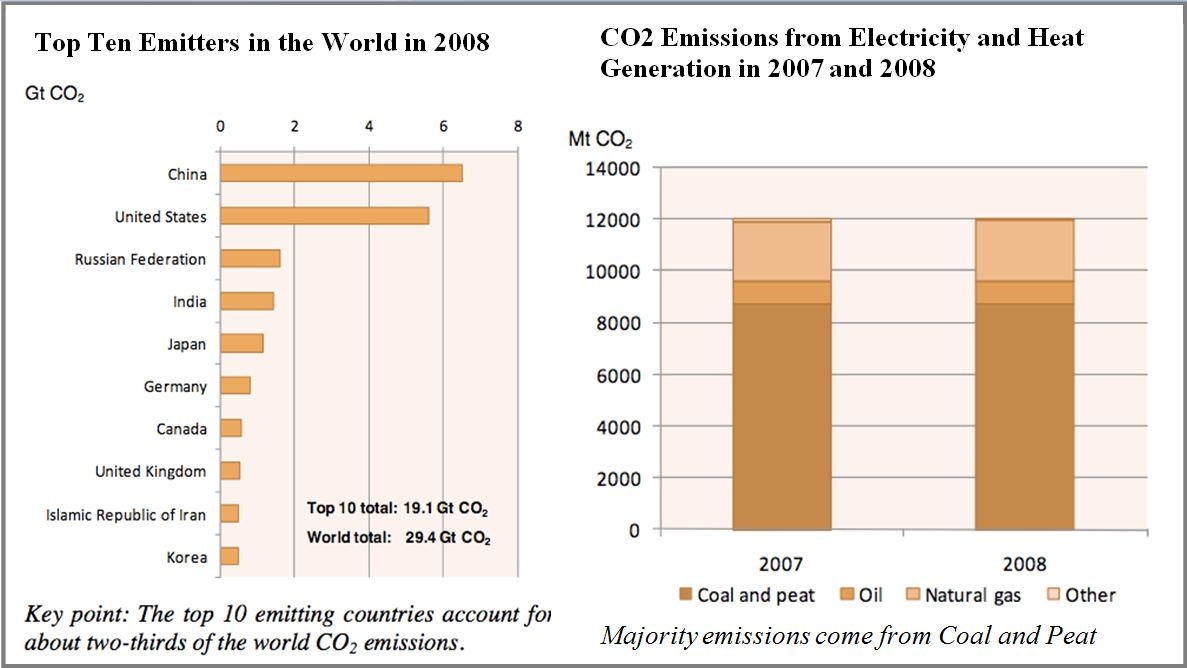
India
The aim of our project was to investigate the implementation of a microgrid in an isolated remote community, to provide the local people’s electricity needs. Here, grid-extension would be unfeasible and the only viable solution would be decentralized energy generation. In general, the majority of the people affected live in rural areas in developing countries. India’s large gap between supply and demand of electricity in rural areas, enormous rural population, and strong potential for the implementation for renewable sources of energy make it a good region for a case study.
India is widely recognized as one of the strongest and fastest-growing emerging economies. Yet in 2009, only 66.3% of the Indian population had access to electricity, rather poor in comparison to their neighbor China’s 99.4%. More interestingly, since an overwhelming majority of Indians, 7 in 10, live in rural areas, the overall electrification rate is dragged down, as the proportion of rural households in India that are electrified is just over a half (2010). Clearly, there exists a huge gap between supply and demand in rural areas. The diagram below further emphasizes this.
One of the reasons why overall electrification rates are low in India is the fact that the traditional approach of grid-extension is difficult, and often impossible [i] in the short run. More specifically, disincentives of poor load factors, dispersed demand and harsh terrains discourage utilities across the country [ii]; thus, connecting rural India to the national grid is not the optimal solution, nor is it the most efficient way to utilize the country’s resources. The Indian government, recognizing this problem, declared in their 2005 electricity policy that in this case “decentralized distributed generation facilities together with local distribution network would be provided so that every household gets access to electricity” [iii]. Hence, there is a strong need for microgrids in rural India, to provide hundreds of millions of citizens access to electricity.
The Current Electricity Situation
India’s primary method of providing power to its people is the conventional centralized power plant system.
Key Statistics:
-
Power Generation (Nov 2010) [iv]
- Total Installed Capacity: 167,077.36 MW
- Two thirds of the total power generated comes from thermal sources; coal alone accounts for half of the total.
- Renewable energy sources, excluding large hydro, represent a mere 7.7%.
- Only 3% of the energy comes from decentralized sources [v].
- Transmission and Distribution Losses: 32.53% (2003-2004)
-
Electricity Access [vi]
- Electrification Rate: 66.3%
- Population Without Electricity Access: 403.7 million
Nevertheless, as noted earlier, the Indian government has recently encouraged microgrids where appropriate, and as such launched the Rajiv Gandhi Grameen Vidytikaran Yojana (RGGVY) in April 2005. Under this rural electrification program, by the new definition [1], several states have provided electricity to all of their villages. However, there still remain states with electrification rates below 35%, such as Bihar.
This government effort, launched in April 2005, aims to provide access to electricity to all rural households; moreover, those living below the poverty line will obtain electricity connection for free. The program has allowed several states to reach 100% electrification rates, including Punjab, Gujarat and Tamil Nadu.
Rajiv Gandhi Grameen Vidytikaran Yojana (RGGVY)

This government effort, launched in April 2005, aims to provide access to electricity to all rural households; moreover, those living below the poverty line will obtain electricity connection for free. The program has allowed several states to reach 100% electrification rates, including Punjab, Gujarat and Tamil Nadu. Through their website , you can check how many villages are electrified; in addition, the status of the work being done in a particular village is also updated on the website.
India is the third largest producer of coal, fourth largest importer, and third largest generator of electricity using this resource. This poses significant environmental concerns, as India comes fourth in the list of the biggest CO2 emitters in the world [vii]. Moreover from 2007 to 2008, CO2 emissions from electricity and heat generation remained constant. The resulting environmental degradation is unsustainable.
Hence, we must prioritize renewable sources of energy, when trying to meet the large rural demand for electricity. While this task is challenging, India has a huge potential for many clean resources, including solar, wind, water and biomass. We explore the different energy sources, investigating their pros and cons to find the optimal solution. The table below gives an idea of the untapped resources India has at its disposal:
Clearly, power derived from biomass, wind, small hydro and solar radiation have the greatest potential. The next question for us was, which of these apply to our specific region, a village in Bihar?
[1] A village is electrified if:
The Definition of Electrification in India
The older definition declared a village electrified "if electricity is being used within its boundary for any purpose."
References
[i] ( Nouni et al., 2007, 2008) 2010 5th International Conference on Industrial and Information Systems, ICIIS 2010, Jul 29 - Aug 01, 2010, India
[ii] Kamalapur G D, Udaykumar R Y. Electrification in rural areas of India and consideration of SHS. 2010 5th International Conference on Industrial and Information Systems,
ICIIS 2010, Jul 29 - Aug 01, 2010, India
[iii] http://www.powermin.nic.in/whats_new/national_electricity_policy.htm
[iv] http://www.powermin.nic.in/index.htm
[v] Need of independent rural power producers in India—an overview, Kuldeep Ojha
[vi]
http://www.iea.org/weo/database_electricity10/electricity_database_web_2010.htm
[vii] http://www.iea.org/textbase/nppdf/free/2010/key_stats_2010.pdf







